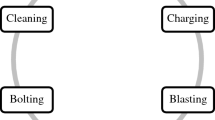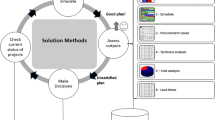Abstract.
This paper describes an efficient procedure for resource-constrained project scheduling problems. It starts with a simulated annealing technique to find a base schedule, and then improves the result by a time-windowing process. Every time-window, which is part of the base schedule, is a basis for a small subproject with two sets of specific constraints. Associated subprojects with time-windows are scheduled to optimality and based on their results the base schedule is updated. The overlapping feature of time-windows makes the displacement of an activity possible within the range of the entire project. The process of creating time-windows, scheduling their associated subprojects to optimality and improving the base schedule is controlled by a feed-back based mechanism that realises a trade-off between computational effort and the improvement made. The computational results indicate that the procedure is promising and yields better solutions than several heuristic algorithms presented in the literature.
Similar content being viewed by others
Author information
Authors and Affiliations
Corresponding author
Rights and permissions
About this article
Cite this article
Zamani, R. An efficient time-windowing procedure for scheduling projects under multiple resource constraints. OR Spectrum 26, 423–440 (2004). https://doi.org/10.1007/s00291-003-0158-y
Issue Date:
DOI: https://doi.org/10.1007/s00291-003-0158-y




